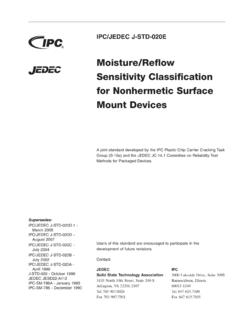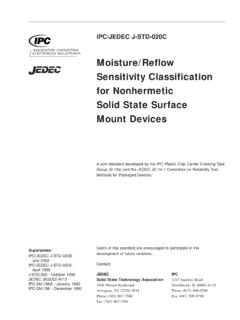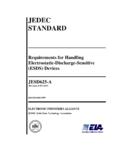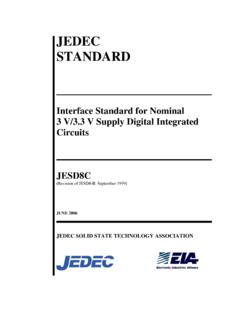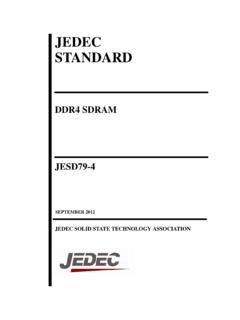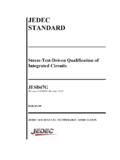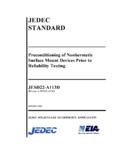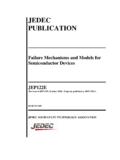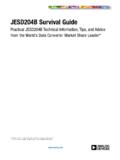Transcription of JEDEC STANDARD - INSIDIX
1 JEDEC . STANDARD . Package Warpage Measurement of Surface-Mount Integrated Circuits at Elevated Temperature JESD22-B112A. (Revision of JESD22-B112, May 2005). OCTOBER 2009. JEDEC SOLID STATE TECHNOLOGY ASSOCIATION. NOTICE. JEDEC standards and publications contain material that has been prepared, reviewed, and approved through the JEDEC Board of Directors level and subsequently reviewed and approved by the JEDEC legal counsel. JEDEC standards and publications are designed to serve the public interest through eliminating misunderstandings between manufacturers and purchasers, facilitating interchangeability and improvement of products, and assisting the purchaser in selecting and obtaining with minimum delay the proper product for use by those other than JEDEC members, whether the STANDARD is to be used either domestically or internationally.
2 JEDEC standards and publications are adopted without regard to whether or not their adoption may involve patents or articles, materials, or processes. By such action JEDEC does not assume any liability to any patent owner, nor does it assume any obligation whatever to parties adopting the JEDEC standards or publications. The information included in JEDEC standards and publications represents a sound approach to product specification and application, principally from the solid state device manufacturer viewpoint. Within the JEDEC organization there are procedures whereby a JEDEC STANDARD or publication may be further processed and ultimately become an ANSI STANDARD . No claims to be in conformance with this STANDARD may be made unless all requirements stated in the STANDARD are met. Inquiries, comments, and suggestions relative to the content of this JEDEC STANDARD or publication should be addressed to JEDEC at the address below, or call (703) 907-7559 or Published by JEDEC Solid State Technology Association 2009.
3 3103 North 10th Street Suite 240 South Arlington, VA 22201-2107. This document may be downloaded free of charge; however JEDEC retains the copyright on this material. By downloading this file the individual agrees not to charge for or resell the resulting material. PRICE: Please refer to the current Catalog of JEDEC Engineering standards and Publications online at Printed in the All rights reserved PLEASE! DON'T VIOLATE. THE. LAW! This document is copyrighted by JEDEC and may not be reproduced without permission. Organizations may obtain permission to reproduce a limited number of copies through entering into a license agreement. For information, contact: JEDEC Solid State Technology Association 3103 North 10th Street Suite 240 South Arlington, VA 22201-2107. or call (703) 907-7559. JEDEC STANDARD No. 22-B112A. Page 1. Package Warpage Measurement of Surface-Mount Integrated Circuits at Elevated Temperature (From JEDEC Board Ballot JCB-09-61, formulated under the cognizance of the Subcommittee on Reliability Test Methods for Packaged Devices.)
4 1 Scope The purpose of this test method is to measure the deviation from uniform flatness of an integrated circuit package body for the range of thermal conditions experienced during the surface-mount soldering operation. 2 Background When integrated circuit packages are subjected to the high-temperature solder reflow operation associated with circuit board assembly, deformation and deviation from an ideal state of uniform planar flatness, , warpage, often results. The package warpage during board assembly can cause the package terminals to have open or short circuit connections after the reflow soldering operation. Certain package types, such as ball grid arrays (BGAs), have been found to be more susceptible to component warpage. Intrinsic package warpage is largely driven by coefficient of thermal expansion mismatch between the various packaging material constituents, but can also be affected by absorbed moisture.
5 Package warpage is temperature dependent, and the final warpage state is a function of the entire temperature history or reflow profile. JESD22-B108A measures device terminal coplanarity only at room temperature and cannot be used to predict warpage at elevated temperatures. The worst-case warpage may be at room temperature, maximum reflow temperature, or any temperature in-between; consequently, package warpage must be characterized during the entire reflow soldering thermal cycle. Critical engineering evaluations of the package and printed circuit board warpage should be conducted in the laboratory under simulated reflow conditions. For many packages, warpage can change with continued reflow cycles so this measurement should be made and reported for the first reflow cycle. 3 Terms and definitions concave warpage: Negative (-) warpage resulting in the package corners being farther from the contact plane than the center of the bottom surface of the package substrate.
6 Contact plane: A plane parallel to the reference plane passing through the lowest contact point on the package substrate. convex warpage: Positive (+) warpage resulting in the package corners being closer to the contact plane than the center of the bottom surface of the package substrate. Test Method B112A. (Revision of Test Method B112. JEDEC STANDARD No. 22-B112A. Page 2. 3 Terms and definitions (cont'd). deviation from planarity: The difference in height between the highest point and the lowest point on the package substrate bottom surface measured with respect to the reference plane. digital image correlation: A 3D imaging technique utilizing multiple triangulated cameras and computerized image matching. fringe projection: The projection of structured light on the sample utilizing image processing to determine package surface displacement.)
7 Laser reflectometry: Use of a confocal microscope to determine focal plane and thereby measure the displacement of a surface. package warpage: The maximum distance between the contact plane and the bottom package surface within the measurement area. peak reflow temperature: The maximum package reflow temperature as specified in J-STD-020 depending on package dimensions and whether the product is intended for eutectic Sn-Pb or Pb-free reflow soldering temperature. rated moisture sensitivity level (MSL): The moisture sensitivity level as determined by J-STD-020. reference plane; regression plane: A least-squares fit of all the bottom-side or top-side measurement points on a package. shadow moir : Referring to an optical noncontact method to measure warpage using a moir . fringe pattern resulting from the geometric interference between a flat reference grating and the projected shadow of the grating on a warped test object.
8 Concave (-) Warpage Convex (+) Warpage Reference Plane Contact Plane Figure 1 Package warpage convention Test Method B112A. (Revision of Test Method B112. JEDEC STANDARD No. 22-B112A. Page 3. 4 Reference documents (informative). JEITA ED-7306, Measurement methods of package warpage at elevated temperature and the maximum permissible warpage JEP-113, Symbols and Labels for Moisture Sensitive Devices J-STD-020, Moisture/Reflow Sensitivity Classification for Nonhermetic Solid State Surface Mount Devices. JESD22-A113, Preconditioning of Nonhermetic Solid State Surface Mount Components Prior to Reliability Testing. JESD22-B100, Physical Dimensions. JESD22-B108, Coplanarity Test for Surface-Mount Semiconductor Devices. 5 Measurement instrument requirements General Metrology Considerations Warpage metrologies such as Shadow Moir , 3D Digital Image Correlation, Fringe projection (structured light phase modulation), and various forms of line scanning and/or high-resolution focusing based tools have been successfully applied and validated under ambient test conditions.)
9 A few of these tools have been successfully adapted and commercialized to support in-situ package warpage measurements at elevated temperatures. This specification focuses on general measurement issues and presents some tool specific considerations. Temperature uniformity across the sample, rate of the temperature ramp, and moisture absorbed in the measurement sample are all important variables. The tool used for elevated temperature warpage metrology should be verified using a concave or convex warpage STANDARD that is invariant to temperature changes across the temperature range of interest, as outlined in clause 6. Measurement accuracy should be verified at temperature extremes such as through the use of a concave or convex ground glass manufactured from ultra-low-expansion material such as Zerodur optical ceramic with a coefficient of linear expansion between 20 C and 300 C of x 10-6/ C.
10 Periodic repeatability measurements should be conducted at elevated temperature using the high temperature warpage STANDARD . Reproducibility of test data should be initially evaluated with respect to any operator-to-operator, day-to-day, or other extrinsic factors which may potentially influence tool performance. Once successfully validated, the tool should be routinely calibrated and monitored on a periodic basis. Sample preparation, temperature profiling, and sample temperature distribution guidelines should be followed according to clause 7 of this document. Test Method B112A. (Revision of Test Method B112. JEDEC STANDARD No. 22-B112A. Page 4. 5 Measurement instrument requirements (cont'd). Thermal Shadow Moir Apparatus (Figure 2). Camera to capture shadow moir pattern Ronchi ruled grating made from low CTE glass, specifically defined lined pitch grating through which light passes to cast a shadow moir pattern onto the sample.)
